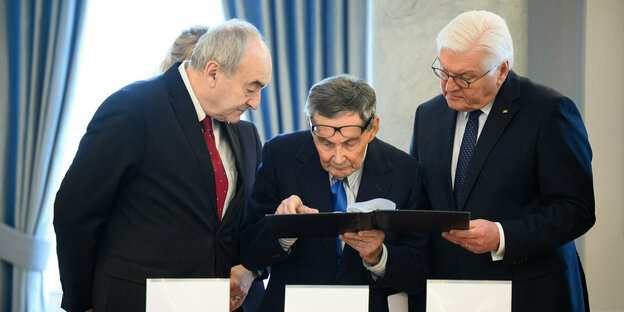Marian Turski (98) asks Germans to save Holocaust documents. He was recently given photographs of the Warsaw ghetto.

Frank-Walter Steinmeier gives Marian Turski photographs of German hospital nurse Helmy Spethmann from the Warsaw Ghetto Photo: Bernd von Jutrczenka/dpa
taz: Mr. Turski, a few days ago you, as a representative of the Polin Museum of Jewish History, received 23 photographs of the Warsaw Ghetto. What do these images show?
This 98-year-old man is a Holocaust survivor and is still active as a journalist today. He heads the history department of the left-liberal news magazine Polityka. In addition, he is, among other things, president of the International Auschwitz Committee and president of the POLIN Council of the Historical Museum of Polish Jews in Warsaw.
Marian Turski: The photographs were taken by German hospital nurse Helmy Spethmann. They show scenes of everyday life in the ghetto: streets, people waiting for something: maybe work, food, a bit of luck? It is very cold. It is raining and there is wind. And 1941 wasn't even the worst time. The tram still runs under the sign “Muranow”. But there are also images that show death, a burial near the Jewish cemetery or even in the cemetery. A wooden hearse, gravediggers, emaciated dead on stretchers, a rabbi.
How important are these images to the history of the Warsaw Ghetto?
They are extremely important. In general, all photographs documenting the Holocaust are very important. However, we differentiate images primarily based on the photographer's intention. The images from the propaganda company of SS leader Jürgen Stroop are important because we have no others from the liquidation of the Warsaw ghetto. But when German soldiers cut off the beards and locks of Polish Jews and photographers press the shutter button, the intention is clear: contempt and humiliation. But for us the images are important because they show the victims' journey from dehumanization to destruction.
And Helmy Spethmann. What motive did the Wehrmacht nurse have?
This is difficult to say. President Frank-Walter Steinmeier also addressed this issue when he gave us the photographs. Because Mrs. Spethmann also wrote some letters to her sister in the German Reich, where she briefly describes “the great misery in the Jewish quarter” and the “epidemic exclusion zone, which was strictly prohibited to enter.” She announced several times in her letters that she wanted to tell us more about this once she returned home. But she never seems to have done that. And she hid the photos in the cover of a photo album. She seems to have been afraid. Only on her deathbed did he entrust the album to her niece.
But can't you read the photographer's intentions in the photographs?
Personally, I assume he took the photographs out of empathy for Polish Jews, but then he was afraid of his own courage. When President Steinmeier presented the 23 photographs to us, he quoted Rachela Auerbach, one of the few survivors of the Warsaw ghetto uprising in 1943. I wrote the quote: “With an iron broom, the first cold days sweep away those who are already In the streets live those who have sold all their clothes and are weak as autumn. The incredible vitality of the Jews of Warsaw is in vain. They scream and defend themselves until the end, until the last hour and minute, but that hour and minute will come.” Steinmeier found the right quote, because that is exactly what Helmy Spethmann's images say.
Why was the family so hesitant to donate the ghetto photographs to Polin or another Polish museum?
Don't know. But as a Holocaust survivor, I have a great request for all Germans, for the grandchildren and great-grandchildren of those who participated in the war: you are not to blame. You inherited history as it is. But this is my fervent calling: he looks in drawers, old suitcases and photo albums! There may also be photographs of Polish ghettos or German-occupied Poland. Don't throw away these photos and souvenirs! They are of great value to us. The Polin Museum appreciates every tip, no matter how small.
This Saturday marks the 79th anniversary of the liberation of Auschwitz. What does this mean to you as a former Auschwitz prisoner?
For me personally, January 27, 1945 was not yet liberation day. That did not happen until May 9, when I was liberated there after the second death march from Buchenwald to Theresienstadt. But he had typhus, was completely apathetic and could not feel even a spark of joy. But generally speaking, for us Jews, January 27 is the day of liberation.
On one of the last days of commemoration, you called on Europeans: “Do not be indifferent!” For several days, hundreds of thousands of people have taken to the streets in Germany to protest against the AfD. In Poland, around twelve million Poles expelled the ruling National Populists in October 2023. Is that what you do?
Yes absolutely. Protesters in Germany have already realized that they have to defend themselves against populists and anti-Europeans before they can destroy democracy. In Poland the situation is different. Here, citizens had to watch for eight years as corruption spread with impunity and the ruling Law and Justice (PiS) undermined the rule of law. Millions of Poles understood that each individual can do something to save the Polish state. Never before have so many Poles gone to the polls, more than 70 percent of those eligible to vote. I don't want to say that this is my achievement. But yes: the Poles have understood that they cannot passively and indifferently observe the disastrous course of time. Rather, they must individually take the defense of democracy into their own hands. And that's what they did.